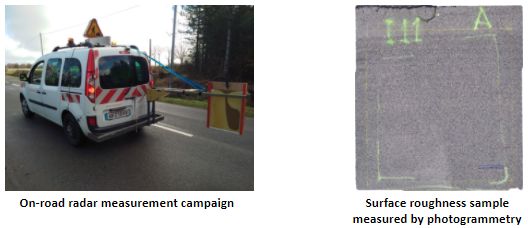Characterization of the surface roughness of roadways by Ground Penetrating Radar
Master thesis- Axis:
- Production, stockage et gestion de l’énergie
- Site :
- Nantes
- Type:
- Master thesis
- Supervising person(s):
- Nicolas Pinel
CEREMA, Université Gustave Eiffel, IETR Laboratory

Context:
Ground penetrating radar (GPR) is a common tool for nondestructive testing of civil engineering materials, environment and agriculture. It allows rapid data collection and is widely used to measure or to estimate media parameters (pavements, bare agricultural fields, soils…).
Here, we are interested in roadways probed by GPR, in the context of wide band GPR, such that the roughness of the pavement surface cannot be neglected anymore. Electromagnetic wave scattering from a rough interface leads to less energy being recorded by the receiver in the specular direction. This should be accounted for in order to accurately retrieve the EM (electromagnetic) properties of the sounded pavement. Nondestructive testing is also of great interest in order to analyze the structural health of the pavement material. Indeed, it is important to be able to detect embedded cracks inside the material, because they are diagnosis elements which influence the application of maintenance and management policies.
Project description:
The first goal of this study is to analyse measurement data of the surface roughness of three samples of pavement surfaces, obtained by photogrammetry. The main objective of this task is to study the main statistical parameters that describe the surface roughness: height probability density function (PDF) and height autocorrelation function.
Then, two options are possible. The first option is to make comparisons between two computation codes (two different numerical methods). The first one is a frequency domain integral method, based on the method of moments, that has been developed in the IETR laboratory. The second method is a time domain open source code called gprMax (see https://www.gprmax.com/), which is based on the FDTD algorithm. The interest of this comparison is to better identify the limitations of these two codes.
The second option is to develop an approximate analytical EM model for taking the roughness into account in order to invert GPR signals. This work will be compared with the classical model called Ament model [1], which has the advantage of being easily invertible. Its main advantage is that the main roughness parameter, the RMS (root-mean square) height, is easily retrieved. Nevertheless, its associated drawback is that it is independent of the surface auto-correlation, implying that it cannot be used to estimate the correlation length.
Thus, the aim of this task is to derive an asymptotic model that can be used to retrieve both the RMS (root mean square) height and the correlation length, by inverting synthetic or even real data. This may be a model sounded by physical considerations [2] or an empirical one based on either simulation or measurement data. This model will be validated thanks to the reference use of a numerical method based on the method of moments [3].
References:
[1] W. S. Ament, “Toward a theory of reflection by a rough surface,” Proceedings of the Institute of Radio Engineers, vol. 41, no. 1, pp. 142–146, 1953.
[2] T. Elfouhaily, C.A. Guérin, “A critical survey of approximate scattering wave theories from random rough surfaces,” Waves in Random Media, vol. 14, R1-40, 2004.
[3] C. Bourlier, N. Pinel, and G. Kubické, Method of Moments for 2D Scattering Problems: Basic Concepts and Applications, Wiley-ISTE, London, 2013.
Requested skills:
The applicant should have knowledge / skills in electromagnetics, as well as applied mathematics (probability and statistics, analysis).